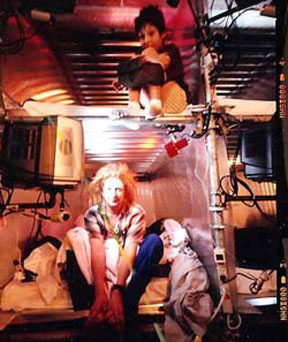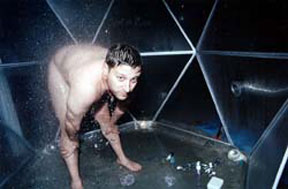~WE LIVE IN PUBLIC


Film Review
AUGUST 27, 2009 by JAN ALBERT
WE LIVE IN PUBLIC
There’s not too many films I can say this about, but I have seen WE LIVE IN PUBLIC, opening Friday, 8/28/09 at the IFC Center on 6th Ave, 3 times already – with pleasure, fascination and a vague sense of discomfort about what it all means.
Directed by Ondi Timoner, this 2009 Sundance-winning doc about dot.com king, Josh Harris, (the film bills him as – “the greatest internet pioneer you’ve never heard of”) is such a densely packed, visually stunning 88 minutes, you’ll jump on and emerge slightly stunned from the roller coast ride that was the JOSH HARRIS life story – before he vanished suddenly from the NYC art scene in 2004. Downtown artworld denizens, including Nancy Smith, the founder of this very web site, as well as many other wide-ranging witnesses are interviewed, about the rise and fall of this oddball Oz.
. . . that is Nancy Smith, with her son Theo, in one of the film’s posters, top image – above.
That’s JOSH HARRIS – in the transparent ‘bunker’ shower at QUIET !! in the following image – above.
Although he is an extreme character, anyone, who grew up as the kid of separated parents, coming home to an empty house and a warm TV, can identify with Josh’s childhood. He fed and entertained himself and absorbed most of his lessons about human relations from Gilligan’s Island, his favorite show. Our story really kicks off in the late 1980s, when Harris, just out of college, sees with astonishing clarity that the Worldwide Web (then just a tech toy at a few universities) will change the world utterly and completely.
The brilliant young market researcher starts pumping out data predicting the Internet will ultimately attract the eyes and ears of the nation, replacing magazines, newspapers, radio and TV. Businesses line up to pay for the oracle’s advice on how best to utilize the web and when his first company, Jupiter, goes public, Josh Harris suddenly has (very) big money to play with.
It was an era, as one person in the film, puts it, when computer nerds become Gods because they knew how to set up a modem. Timoner does such an entertaining job of explaining the financial machinations of the first dot.com boom/bust, that even number-challenged viewers such as myself understand how in short order, Harris became a multi-millionaire.
What did he do with his cash? One witness terms it, “The most entertaining expenditure of money I have ever seen”.
In 1994, he started Pseudo.com, a big online party, decades ahead of the curve. It attracted the downtown art and music crowd and featured some of the first interactive programs, with streaming video. You had to have the patience of a Buddha to watch it in the days before broadband, but even the good old reliable TV news magazine, 60 Minutes, could sense something big was happening. It traveled down to Soho to interview Harris at the Pseudo studios, where the brash young visionary declared, “I’m here to take 60 Minutes out.”
Harris, like the rest of his generation, loves the spotlight and notes, how in Andy Warhol’s day, everybody wanted to be famous for 15 minutes. “Now, everybody wants to be famous for 15 minutes every day.”
He alarms his investors and attracts even more attention when he stops wearing suits and ties and shows up at board meetings as his artworld alter ego, a deranged clown, dubbed “Luvvy”, in full make up and costume.
When he started Pseudo, he was worth $80 million (from the sale of Jupiter – the first-ever web trend tracking site) and, he went on to spend a good chunk of that dot.com dough celebrating the turn of the millennium by staging a happening on a scale of such exuberance and excess, nothing like it had been seen since NYC in the 60’s or maybe since shortly before Rome started burning.
Artworld observers and participants such as Jeffrey Deitch, Leo Koenig, Donna Ferrato, and Alana Heiss still talk about QUIET-WE LIVE IN PUBLIC – as it was called – with awe and wonder.
Harris had the ground floor of an old factory building, (as well as the 4 full floors of an adjacent building!!) at the edge of Chinatown, just south of Canal Street, gutted, and then paid a small group of artists and provocateurs to install a chapel, communal dining hall, bathroom, showers, bed pods, an interrogation room, a firing range, equipped with dozens of machine guns, oh, and 75 cameras, placed throughout the environment. It got to be that up to 100 artists, and counting, were invited to come live and work in the installation around the clock as in-house crew. He announced that food, drink, everything was free, “except the video we capture of you.” Once in, they weren’t allowed out and Harris, like an impassive “puppet master” sat back to see what would happen. If that wasn’t party enough, he then opened the whole place up to the public 24/7 and huge crowds of art fans and New Year’s Eve revelers alike, poured in, in ever-increasing waves, during that last week of 1999.
Wading through the hundreds of hours of footage Harris gathered and stored away for almost a decade, Timoner captures the escalation from the delight of performing on camera 24/7, to the detachment about being watched peeing, sleeping and having sex all the time like moneys in a zoo. There are emotional breakdowns, bad behavior, exhibitionism, and even a short but potent flip-out by one artist (ok. this site’s Nancy Smith), which got her temporarily evicted from the cabal, until the whole jamboree was shut down permanently by the FDNY on the morning of January 1, 2000.
But the best is yet to come: (Did I tell you this film is just 88 minutes long?!) Since Harris filmed virtually everything he did during this period, we have the pleasure of watching him fall in love and undertake his next project. This time, as Harris remembers, he is “the rat in the maze.”
Josh and his girlfriend, Tanya, (who is also interviewed, looking back at the intense time they shared) had motion activated cameras placed in every part of their loft and decided to”live in public”, inviting web viewers to watch and comment on their relationship around the clock. They begin with much-hyped media coverage and the
“Feeling that love will conquer all,” and there are some fun moments, my favorite being when Tanya misplaces her wallet and asks viewers to text and tell her where it is !
But let’s face it, there’s enough pressure on young love without an audience and I’ll just cut to the chase here. Harris finishes the experiment alone and on the toilet, reading the financial pages and calling his bank to learn that he is broke.
But that’s not the end of the Josh Harris saga. Timoner rediscovers him in 2005 living quietly on an apple farm in upstate N.Y., preparing to make his comeback.
What does Josh Harris do now that the vision of the Internet he predicted has finally become reality? Now, that there are face books for people who don’t read and people sharing what they had for breakfast online? Now, that TV is trying to keep up by focusing cameras on Jon and Kate, The Real World, Big Brother, and The Biggest Loser?
See the film to find out what happens next, but let me say the ending is no let down from the mesmerizing trip Ondi Timoner orchestrates throughout WE LIVE IN PUBLIC.
see: WE LIVE IN PUBLIC/the official website – with TRAILER !!
